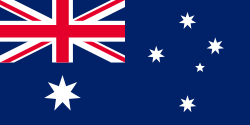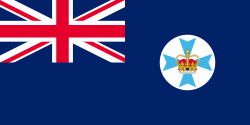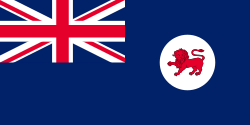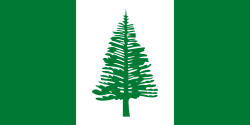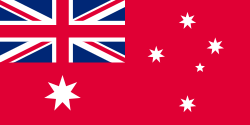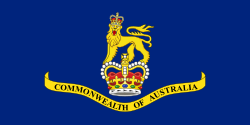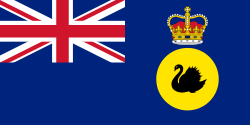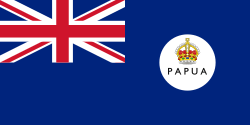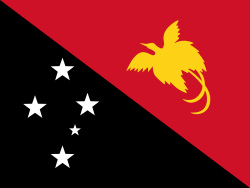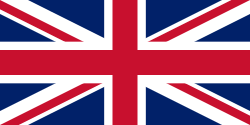| Flag | Date | Use | Description |
|---|
 | 1982–present | Armorial Flag of the City of Adelaide [16] | Blue background divided into four quarters by a Saint George's Cross outlined in gold overlain with the Arms of the City of Adelaide. Flag bordered on three sides by diagonal blue and gold stripes. [17] |
| Link to file | | Flag of the local government area of Anangu Pitjantjatjara Yankunytjatjara [18] | The logo of Anangu Pitjantjatjara Yankunytjatjara on a red field. |
 | 1947–present | Flag of the City of Brisbane [19] | Blue background (representing the Brisbane River) bordered by a golden checker pattern (representing the Sun and Brisbane's warm climate) with the flag divided into six quarters. The upper hoist quarter contains a golden caducei superimposed on wavy white lines, representing the Brisbane River and its ties to the city's commerce. The lower hoist quarter contains two Stafford knots and a white star arranged vertically (all represent the achievements in astronomy of Sir Thomas Brisbane, for whom the city is named). The remaining segments alternate between these two designs. The flag design is based on the shield on the coat of arms of Brisbane. [20] [21] |
 | 2009–present | Flag of the City of Darwin [22] | According to council policy, Darwin maintains both the coat of arms flag and a logo flag. [22] |
 | | Flag of the City of Hobart [19] | The flag of Hobart City Council, of Tasmania, Australia. Designed in 1951 by Hobart architect and alderman, I.G. Anderson and first flown in 1953. The star is derived from the arms of Lord Hobart, 4th Earl of Buckinghamshire (1760–1816), Secretary of State for War and the Colonies at the time of colonial settlement (1804), and after whom Hobart is named. The colour used on the arms Lord Hobart was, in fact, sable (black), rather than blue. The red lion is from the Tasmanian flag – and its location at the top of the shield signifies Hobart's position as the Capital City. [23] |
 | | Flag of the City of Melbourne [19] | White background divided into four quarters by a Saint George's Cross outlined by a concise and overlain with St Edward's Crown. Quadrant features represent the main activities of the economy of the City of Melbourne in the mid 19th century and are, in a clockwise direction from top left, a fleece hanging from a red ring (wool), a black bull standing on a hillock (cattle), a three-mast ship in full sail (shipping), and a spouting whale in the sea (whaling). The flag design is identical to the shield on the coat of arms of Melbourne. [24] |
 | 1949–present | Flag of the City of Perth [19] | Saint George's Cross overlaid with the City of Perth coat of arms in the centre. [25] |
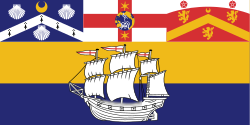 | 1908–present | Flag of the City of Sydney [19] | The flag is a horizontal triband of three colours – white, gold and blue. The top third features three designs. In the top left the arms belong to Thomas Townshend, Viscount Sydney, after whom the city was named. The English Naval Flag in the centre acknowledges the role Arthur Philip played in Sydney's foundation. The red cross is overlaid with a globe and two stars – the principal features of James Cook's Arms, which were granted as a posthumous honour for his service in mapping Australia. The arms in the top right belong to the first Lord Mayor of Sydney, Thomas Hughes. It was during his term of office that the title of Mayor became Lord Mayor, and the official coat of arms for the city was granted. The remaining field of the flag features a ship under full sail, an allusion to the prominence of Sydney as a maritime port. [26] |
| circa 1960–2008 | Flag of the City of Toowoomba [27] | The flag of Toowoomba city is a violet coloured ensign which makes reference to the city's floral emblem of the day, the Toowoomba Violet (aka the sweet violet, Lat. 'Viola odorata'). [28] Notable is the city's coat of arms [29] in the centre of the ensign and the city's name on the left of the flag, lettered from top to bottom. [30] |
| Link to file | 2008–present | Flag of Toowoomba [27] | A new Toowoomba flag was created in 2007 and became the official flag of the Toowoomba Region on 15 March 2008 with the amalgamation of 8 councils; The councils were Clifton Shire, Crows Nest Shire, Cambooya Shire, Jondaryan Shire, Millmerran Shire, Pittsworth Shire, Rosalie Shire and Toowoomba City. [31] The predominant colours are white and teal. The three white rings in the flag intersect to create eight spaces from their loops and exterior, symbolising the unity of the eight amalgamated former councils. The colour of teal also represents unity. [32] |
| Link to file | 1965–present | Flag of Wagga Wagga [33] | The Wagga Wagga City Flag is square. The upper quarter of the flag contains eight stalks of wheat positioned so as to form two capital letters W on a vert (green) field. The lower quarter of the upper half of the flag contains a wavy blue line on gold (yellow) representing the river winding through the wheat fields. The lower half of the flag contains the head of a ram positioned centrally on a vert (green) field. |
 | 1850–present | Upper Murray River Flag [34] | Flown by vessels on the upper reaches of the Murray River, predominantly in Victoria. The blue bars are said to represent the four major rivers that form the Murray-Darling River system and their dark hue represents the darker colour of the Murray River's darker waters in Victoria and NSW. |
 | 1850–present | Lower Murray River Flag [34] | Flown by vessels on the lower reaches of the Murray River, predominantly in South Australia. The blue bars are said to represent the four major rivers that form the Murray-Darling River system and their light hue represents the lighter colour of the Murray River's lighter waters in South Australia. |
| Link to file | 1996–present | Flag of Dangar Island, New South Wales [35] | The black field divided by a white cross represents the Saint Piran's Cross, honouring the Cornish heritage of Henry Cary Dangar, after whom the island is named. The four red eight-pointed stars invoke the New South Wales version of the Southern Cross. In the canton, the yellow tower symbolises the sandstone tower that has stood on the island since 1886, while the mullet serves as a homage to the fact that the island was previously known as Mullet Island. |
| Link to file | 1998–present | Flag of Lord Howe Island, New South Wales [36] | The flag is unofficial. It features a blue background, a white cross of St George and the cross of St Andrew, and a yellow circle in the centre with a blue depiction of the island. |
 | 1996–present | Flag of Scotland Island, New South Wales [37] | |
